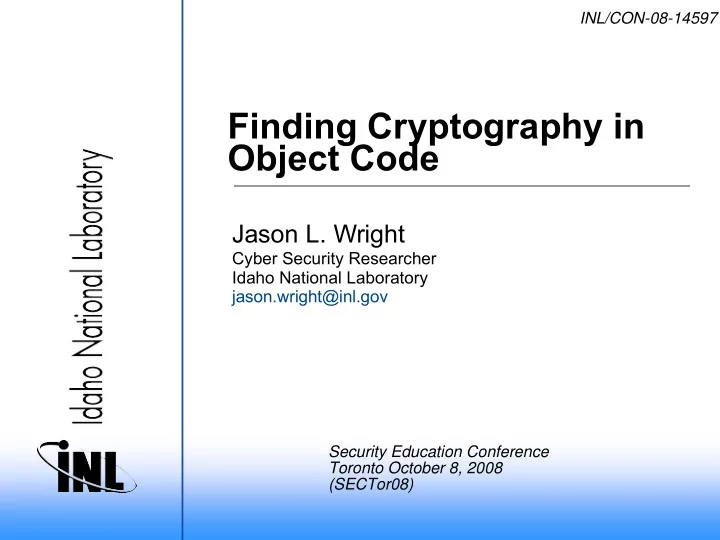

INL/CON-08-14597 Finding Cryptography in Object Code Jason L. Wright Cyber Security Researcher Idaho National Laboratory jason.wright@inl.gov Security Education Conference Toronto October 8, 2008 (SECTor08)
Current Work • Malware is using cryptography • When reverse-engineering, crypto algorithm must be found and identified • The Bad Guys use many obfuscation techniques, but they usually do not change the underlying crypto algorithm
Mifare: Little Security, Despite Obscurity • Henryk Pl ö tz/Karsten Nohl presented at 24C3 (Dec'07) and CanSecWest 2008 (also USENIX Security 08) • Hardware hack of a smartcard crypto algorithm • “ Focus on interesting-looking parts: – strings of flip-flops (registers) – XOR – Units around the edges that sparsely [connect] to the rest of the chip ” • More: http://events.ccc.de/congress/2007/Fahrplan/events/2378.en.html http://www.cs.virginia.edu/~evans/pubs/usenix08/usenix08.pdf
FindCrypt: locating constants • Many algorithms have constants that are unique (MD4, CAST-128, etc). • Easy enough... just search for them: – data segment – text segment • This is findcrypt from Datarescue: http://hexblog.com/2006/01/findcrypt.html http://hexblog.com/2006/02/findcrypt2.html • Also KANAL (plug in for PeiD) http://peid.has.it/
Example: <MD5Init>: push %ebp void mov %esp,%ebp MD5Init(MD5_CTX *ctx) { mov 0x8(%ebp),%eax ctx->count = 0; movl $0x0,0x10(%eax) ctx->state[0] = 0x67452301; movl $0x0,0x14(%eax) ctx->state[1] = 0xefcdab89; movl $0x67452301,(%eax) ctx->state[2] = 0x98badcfe; movl $0xefcdab89,0x4(%eax) ctx->state[3] = 0x10325476; movl $0x98badcfe,0x8(%eax) } movl $0x10325476,0xc(%eax) leave Becomes: ret Most crypto algorithms have these magic constants
void MD5Init(MD5_CTX *ctx) { Example (cont): ctx->count = 0; ctx->state[0] = 0x67452301; ctx->state[1] = 0xefcdab89; 00000000 <MD5Init>: ctx->state[2] = 0x98badcfe; 0: 55 push %ebp ctx->state[3] = 0x10325476; 1: 89 e5 mov %esp,%ebp } 3: 8b 45 08 mov 0x8(%ebp),%eax 6: c7 40 10 00 00 00 00 movl $0x0,0x10(%eax) d: c7 40 14 00 00 00 00 movl $0x0,0x14(%eax) 14: c7 00 01 23 45 67 movl $0x67452301,(%eax) 1a: c7 40 04 89 ab cd ef movl $0xefcdab89,0x4(%eax) 21: c7 40 08 fe dc ba 98 movl $0x98badcfe,0x8(%eax) 28: c7 40 0c 76 54 32 10 movl $0x10325476,0xc(%eax) 2f: c9 leave 0000000000000000 <MD5Init>: 30: c3 ret 0: 03 19 d1 48 sethi %hi(0x67452000), %g1 4: 05 3b f3 6a sethi %hi(0xefcda800), %g2 8: c0 72 20 10 clrx [ %o0 + 0x10 ] c: 82 10 63 01 or %g1, 0x301, %g1 10: 84 10 a3 89 or %g2, 0x389, %g2 IA32 SPARC64 14: c2 22 00 00 st %g1, [ %o0 ] 18: c4 22 20 04 st %g2, [ %o0 + 4 ] 1c: 03 26 2e b7 sethi %hi(0x98badc00), %g1 20: 05 04 0c 95 sethi %hi(0x10325400), %g2 24: 82 10 60 fe or %g1, 0xfe, %g1 28: 84 10 a0 76 or %g2, 0x76, %g2 2c: c2 22 20 08 st %g1, [ %o0 + 8 ] 30: 81 c3 e0 08 retl 34: c4 22 20 0c st %g2, [ %o0 + 0xc ]
A Better Way? Look for behavior... • Don't search for concrete constants • Look for properties unique to cryptographic functions • We'll search for these properties
Look for... •Heavy use of integer operations: a ∧ b a ∨ b – AND/OR – ADD/SUB a ⊕ b – XOR • No floating point operations • XOR is interesting by itself, it's a part of: – DES, SKIPJACK, RC4, BLOWFISH, AES – It has a C operator: c = a ^ b; – Other languages have it too (well, COBOL doesn't)
Looking for XOR... •Not just any XOR will do, however... – XOR %eax, %eax – On many arch's, including IA32, this is very commonly used to “zero” a register (e.g. eax ) – 93% of XOR usage is “zeroing” in Linux glibc •Constant/immediate form: xor $0x103, %eax – Not usually interesting •But memory references and registers are...
Rotation (ROR, ROL, not ROTFL) • Commonly “diffusion” part of “confusion and diffusion” (Claude Shannon) • No C operator, so... – Compiler optimization (libc) – Inline assembler (OpenSSL)
Example: OpenBSD libc • Has quite a bit of crypto: SHA1, MD4/MD5, RMD160, CAST-128, SKIPJACK, DES/3DES, BLOWFISH • 1379 functions total (4.3) • Versions tested all the way back to 2.5 (May 1999!) (Remember a.out?) • Compiler seems to have little effect (gcc 2.8.1, 2.95.2, 3.3.5) • Nor do compiler options (O0 to O3)
Example: Linux libc • Not much crypto... just DES i.e. crypt()
Example: CALC.EXE • Shouldn't have any crypto … and doesn't appear to...
Scoring... • Initially tried a density... score density = numof instructions
Hazards • Changing/obscuring constants ( findcrypt can't deal with this) • FindCrypto not immune to dead/obscured code (combine with dead code analysis?) Notably missing • Asymmetric algorithms (DH, RSA, etc.) e mod n c = m Macro operations on big numbers (>=512bit) d mod n m = c • RC4 (not Feistel cipher)
Questions/Comments?
Recommend
More recommend